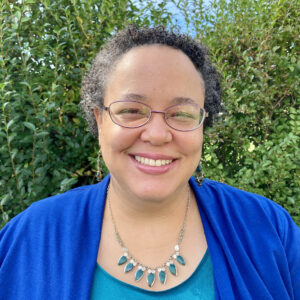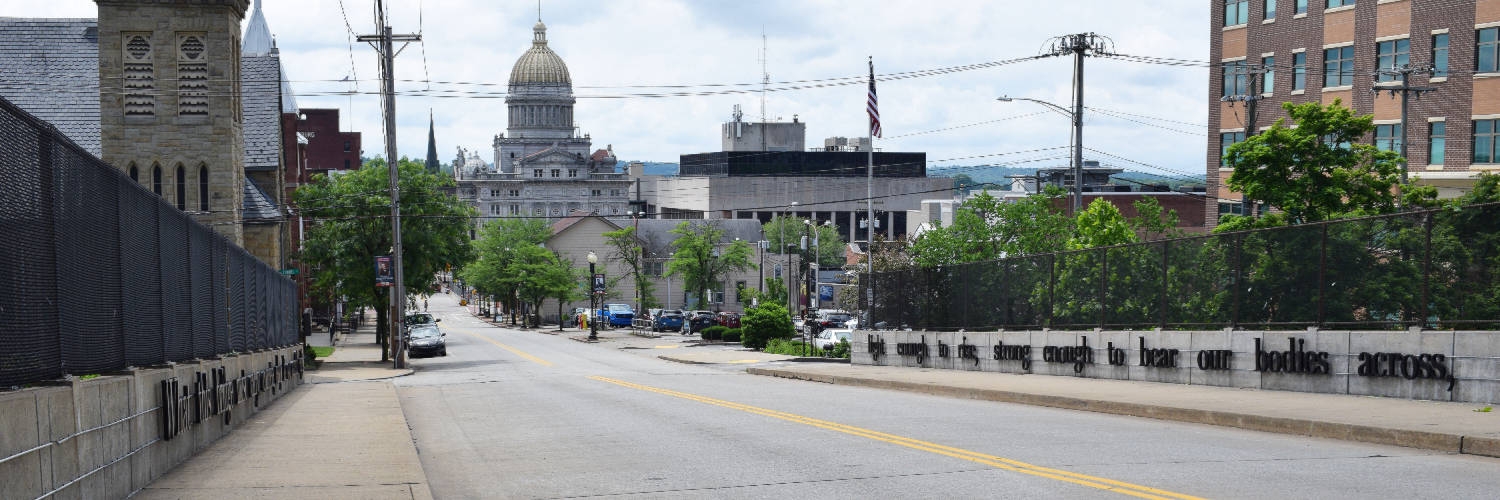Public Art Installation Update on North Main Street Bridge
Transformative language artist Sarah Williams-Devereux’s first stanza installed on Analog Scroll
The first stanza of Sarah Williams-Devereux’s original site-specific commissioned poem was installed on Janet Zweig’s Public Art Analog Scroll, located on the North Main Street Bridge in downtown Greensburg, today, June 14.
“Nexus is the title (of the poem). The word came as I was writing earlier drafts, when I was thinking about the layering and convergence of so much on the single bridge. The bridge, the train tracks, the soil, the people, the history, all interconnected and inseparable,” notes Williams-Devereux. “I’ve been partial to short titles lately, too.”
With a new stanza being installed every month, much like serialized stories were released one chapter at a time, her entire poem will be sequentially revealed to the public over the course of one year.
“There’s an anticipation to see what will come next, something to relish and to look forward to experiencing,” comments Williams-Devereux. “There’s time for a reader to speculate on where the poem will go or where they want it to go.”

Certified in writing group leadership from Amherst Writers & Artists, Williams-Devereux teaches poetry for the Madwomen in the Attic program at Carlow University and is the managing editor for their annual anthology, Voices from the Attic. She is also pursuing an MA in teaching writing from Johns Hopkins University.
Exploring issues of race, sexuality, human connection, compassion, mental illness, and recovery, Williams-Devereux’s work has been published in numerous magazines and anthologies, such as F(r)ictionLog, Snapdragon: A Journal of Art & Healing, Sampsonia Way Magazine, and Pittsburgh City Paper, among others. Most of her poems are semi-autobiographical and drawn from her personal experiences, but the site-specific poem for the Bridging the Gap public art project differed from her previous works.
“For this poem, I conducted a lot more research than I usually do for a poem: the structure of bridges, the history of Greensburg,” explains Williams-Devereux. “Weaving the factual and historical with the emotional into one poem was a welcome challenge.”
Williams-Devereux’s poem was shaped by not just one of the three themes related to the site, but all of them. The commissioned poems were required to relate to one of the following three concepts: the physical site, specifically or to southwestern Pennsylvania; the concept of bridges or bridging; or the idea of “bridging the gap” between downtown Greensburg, the Museum, and the neighborhoods up the hill, or bridging metaphorical gaps such as between classes, neighborhoods, or communities.
“I dug into the history of Greensburg, the indigenous and immigrant peoples who have lived here, the early businesses and the later ones, the city’s namesake, the industries that thrived and fell here, and the complexities of all that history existing in one place at one time. This is where bridging the gap comes in for me. How do we meet each other as human beings? How do we cross these bridges of history and knowledge to get to another side? Are there places where we can meet in the middle? How can we honor those who have laid these physical or societal or cultural bridges before us?”
Sarah Williams-Devereux
Williams-Devereux is the fifth literary artist whose work is being featured as part of the Bridging the Gap project. In total, ten writers will be selected for commissioned works. The next two selected writers and the schedule for their text to appear are Joy Katz, June 2023-June 2024, and Karen Dietrich, June 2024-June 2025. A call for artists to select the final three writers will be issued in the future.
3 Questions with Sarah
1. What sparked your initial love of poetry?
Poetry has always been a part of my life for as long as I can remember. Some of my earliest memories are of writing poems, so that spark was probably in me from before I was born!
2. How do your poems develop? Please guide us through the stages of a poem?
Over the past few years, most of the poems I’ve written have begun as responses to in-class prompts I offer my poetry workshop students. I write along with them. The prompts I offer are fairly open-ended, so our writing is able to go where it needs to go. I usually set aside that first draft for several months before I return to it to see if it’s something that can be shaped into a public piece. I type up the poem, print it, and take time to look at it again to find the heart of it. I may expand or cut or rearrange some sections, depending on what the poem needs. I’ll play with the line lengths and line breaks to see what fits. I sometimes read works-in-progress aloud, which helps me hear very clearly what I need to edit. The title usually comes last. Sometimes it’s a word or phrase from the poem, sometimes it’s a related concept.
3. What are you reading right now?
For fun, various daily poem blogs for National Poetry Month. For graduate school, a mix of books and essays on the writing workshop experience. Pieces by Eric Bennett, Felicia Rose Chavez, Viet Thanh Nguyen, Matthew Salesses, Addie Tsai.
